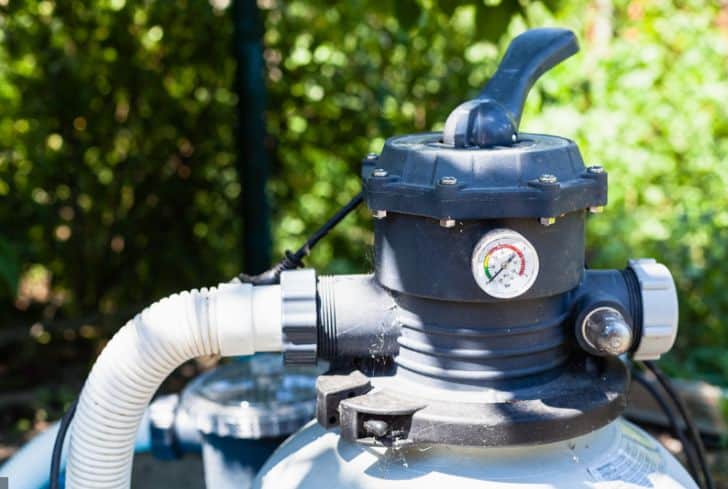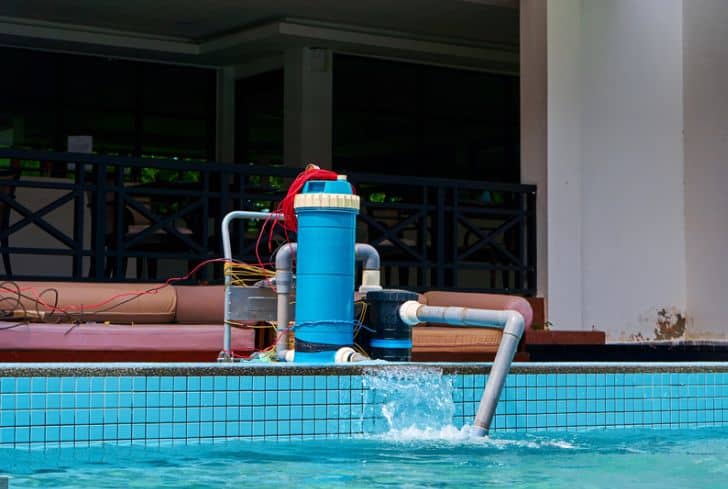A good quality pool pump is indispensable for keeping your pool clean and healthy. I mean, it’s the heart of your pool filtration system! In fact, it works like the human heart by circulating the water by pushing it through the pool filter and back into the pool. That’s how your pool remains clear and sparkling throughout the summer.
And before you buy a new pool pump, equipping yourself with the basics will help you know what to expect and how to prepare for any installation. So, how many amps does a pool pump draw?
Well, herein, I’ve got the answer for you. This blog post examines the amperage draw of 1, 1.5, and 2-horsepower pool pumps and some tips for reducing power usage when operating your pump. Why not stay a while and learn more?
How Many Amps Does a Pool Pump Draw?
The amperage needs of a pool pump depend mainly on the motor’s horsepower and the pump speed you choose. But generally, expect your amp to draw between 10 and 20 amps when running on 120 volts.
The most reliable way to know your pool pump’s power consumption rate is by checking the label. The label will usually tell you the amperage draw for that specific model. But then again, know that the label usually indicates the maximum amperage, so the actual usage is usually lower.
How Many Amps Does a 1 HP Pool Pump Draw?
A 1-HP pool pump will usually draw a maximum of 15 amperes when running on 120 volts. On a larger 240-volt circuit, the amperage draw will be around 7.5 amps. Either way, the amperage of 1-HP models is lower than that of the larger pool pumps due to their smaller size.
Perhaps you’re wondering why we didn’t say that a 1 HP motor needs 746 watts. After all, a horsepower is equal to 746 watts, right? Well, that’s correct. However, we can’t apply that and I’ll tell you that shortly.
You see, the horsepower of any motor tells us about the output and not the input. As such, the output of 746 watts is equivalent to 1-HP, but it doesn’t tell us how much power the motor needs to achieve that output.
Obviously, no motor is 100% efficient. So, to achieve a 1-HP worth of output energy, the motor has to draw more than 746 watts. That’s why we differ from the majority when it comes to giving the amperage. And in fact, the label attached to the motor confirms this.
But generally, when going for a 1-HP motor, expect it to demand as much as 1500 watts when running on maximum amperage. The start-up amperage – the amperage drawn when it’s just starting up – is higher.
How Many Amps Does a 1.5 HP Pool Pump Use?
The amperage draw of a 1.5 HP pool pump is about 20% higher than that of a 1-HP motor – 17.5 amperes when running on 120 volts and approximately 8.75 amperes when connected to a larger 240-volt circuit.
In fact, it’s more accurate to express the amperage as 8.75 since this motor is usually designed to work with 240-volt circuits. And just like the 1-HP pool pump, expect this motor to draw about 2100 watts, more than the actual figure you get when you multiply 1.5-HP by 746 watts.
How Many Amps Does a 2HP Pool Pump Draw?
The amperage draw of a 2-HP pool pump is about 20 amps when connected to a 120-volt circuit and 10 amps when connected to a larger 240-volt circuit. Again, this motor needs more than 1592 watts – the actual figure you get when you multiply 2-HP by 746 watts – to achieve a 2-HP output.
Again, a 2-HP motor doesn’t use twice as much power as a 1-HP motor. That’s because some of the factors affecting power consumption don’t double with the increase in horsepower. And from the calculations, we can see that a 2-HP motor draws 42% more power than a 1-HP model.
How Much Does It Cost To Run a Pool Pump?
The cost of running a pool pump depends on the wattage and the amount of time you keep the pump running. A higher-wattage pump will cost more than a lower wattage. The same applies when running the pump for a longer period of time.
Let’s assume that your pump runs at 1500 watts an hour and that you operate it for 8 hours every day.
In a day, it will need;
1500 x 8 = 12000 watt-hours or 12 kilowatt-hours (kWh).
In a month, running your pump for 8 hours per day;
12000 x 30 = 360000 watt-hours or 360 kilowatt-hours (kWh).
Let’s assume your rate is 15 cents per kilowatt hour.
In a day, it will cost;
12 x 0.15 = 1.8 dollars
In a month, it will cost;
360 x 0.15 = 54 dollars.
So, it is evident that the cost of running a pool pump depends on the pump’s wattage and the average running time.

What Size Breaker Do I Need for a Pool Pump?
The size of the circuit breaker you need for your pool pump depends on the pump’s amperage draw. Most pool pumps range between 10 to 20 amps. The rule of thumb is that the breaker needs to be 125% of the amperage draw of your pump.
When shopping for a breaker, most people consider compatibility with the main electrical panel and the brand. And while we won’t downplay the importance of compatibility and brand, size is another crucial aspect of your buying decision.
To determine the correct amp breaker size, factor in the amperage of the unit you’re trying to protect. The ideal breaker should be larger than the amperage of your machine and at least 125% of its load capacity.
For instance, if your pump needs a 15-amp motor, the ideal breaker size should be 18 amps. Of course, you have to get a 20-amp breaker because we don’t have one rated at 18 amps. But the thing is, it’s always good to go slightly higher than the actual amperage.
Is It Possible To Use a Pool Pump With Less Than 50 Amps?
Yes, you can use a pool pump with less than 50 amps. In fact, some pumps can operate using as little as 15 amps. However, it is essential to note that using a pump with less amperage will result in reduced performance and efficiency.
It is also crucial to note that the amperage rating of a pool pump depends on the size of the motor, and different sizes come with different amps. But generally, a 50-amp circuit breaker is more than enough for most pool pumps.
Should I Use GFCI Protection?
The National Electric Code (NEC) recommends a ground fault circuit interrupter (GFCI) for all pool pumps, whether you have an inground pool and above-ground pool. Pool pumps work in wet environments, so it’s essential to protect them from electrical shock risks. A GFCI breaker keeps you from electrical shocks when using a pool pump.
A GFCI device works by monitoring the flow of electricity from the pump and will shut off the power in case of unexpected changes. Of course, that’s an aspect you can’t afford to overlook when dealing with your pool’s electrical equipment.
Ways to Reduce the Cost to Run a Pool Pump
Reducing the cost of running a pool pump is essential for keeping energy bills low. A pool pump is one of the high energy-consuming appliances in the home, so it is vital to put some effort into reducing its energy consumption.
Here are some tips that can help you reduce the cost of running a pool pump;
Use Variable Speed Pumps
One-speed pumps run on a particular speed and draw a specific amount of amps. Replacing them with dual or variable-speed pumps will allow you to control the speed of the pump, thereby reducing the amps drawn.
Limit The Running Hours
Pool pumps don’t need to run continuously to keep the pool clean. Limit the unit’s running time and switch it off after a while. But to do that without compromising the quality of your pool water, know the time it takes for complete circulation. You can calculate that by dividing the total water volume by the flow rate of your pump.
And when adopting this cost-reduction strategy, ensure that you don’t do it at the cost of using more chemicals. After all, it wouldn’t make sense to save energy but spend more on chemicals.
Get a More Efficient Pump
Manufacturers often install standard pumps, which are less efficient than energy efficient (EE) and high-efficiency (HE) models. Installing an EE or HE pump can reduce power consumption by 25%.
Upgrade Your Filter
It’s one aspect that most pool owners are likely to overlook. But then again, an aging pool filter can’t trap dirt efficiently. That results in more resistance in the water, eventually increasing your pump’s running cost. So, to avoid all that, use a larger filter that’s more efficient at trapping dirt and one that has less resistance to the water flow.
Go For Low Horsepower
I may sound controversial, but you don’t need higher horsepower pump to get a higher flow rate. In pumps, HPs don’t exactly signify how hardworking they are. A ¾ HP pump may offer the same flow rate as a 1 or 1.5-HP model, so look for a model whose HP is low but whose flow rate is high.
Use Supplemental Sanitizers
You can reduce the workload of your pool pump by bringing in supplemental sanitizers like enzymes, ozone, and clarifiers. These products will reduce the amount of work done by your filter and hence the resistance to the water flow.
Does Your Pool Pump Use 115V or 230V?
Usually, the voltage of your pool pump depends on the motor’s HP rating. The smaller HPs connect to either 115V or 230V circuits, while the bigger ones go with only 230V. So before buying a new pump, check its power rating and determine whether you need a 115V or 230V circuit.
Remember that voltage is essential when deciding the pump’s compatibility with your electrical service. Wrong decisions here can lead to severe consequences, so make sure you buy the right one.
Final Verdict
Homeowners don’t often think of the amps their pool pump draws until something goes wrong, and that’s when they realize how significant it can be. So ensure you know the amp draw of a pump before you get one.
The amperage should tell you whether your current electrical configuration is adequate to handle the pump’s power requirements. And if it isn’t, you need to get a professional electrician to upgrade your system. The new configuration needs to factor in voltage, minimum breaker size, and ideal wiring for your new investment.






